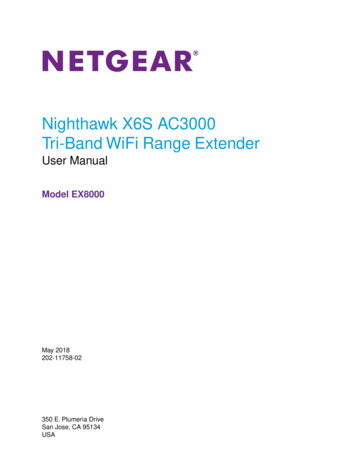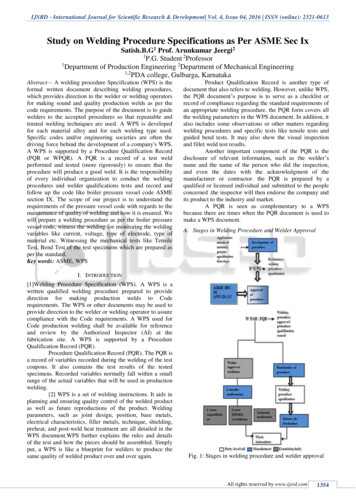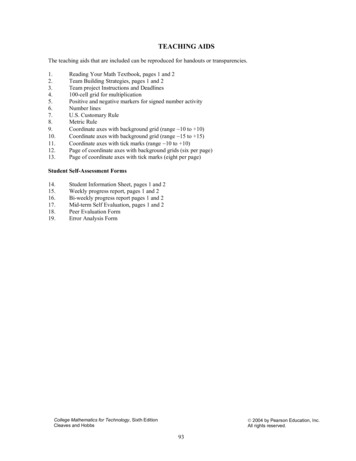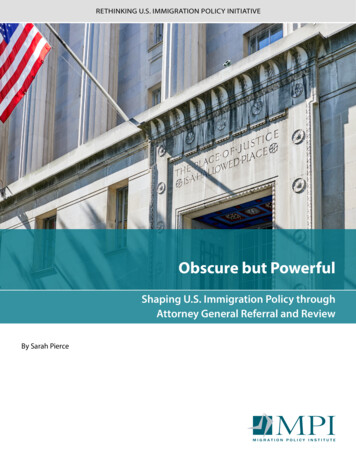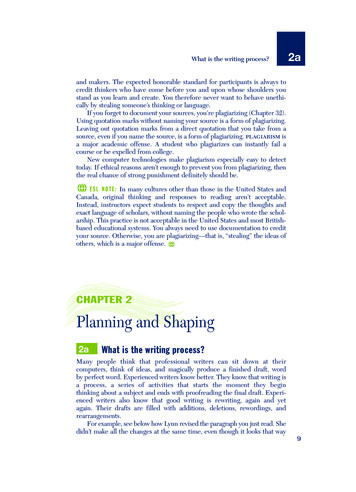
Transcription
TROYMC01 09 0131889567.QXD1/27/066:07 PMPage 9What is the writing process?2aand makers. The expected honorable standard for participants is always tocredit thinkers who have come before you and upon whose shoulders youstand as you learn and create. You therefore never want to behave unethically by stealing someone’s thinking or language.If you forget to document your sources, you’re plagiarizing (Chapter 32).Using quotation marks without naming your source is a form of plagiarizing.Leaving out quotation marks from a direct quotation that you take from asource, even if you name the source, is a form of plagiarizing. plagiarism isa major academic offense. A student who plagiarizes can instantly fail acourse or be expelled from college.New computer technologies make plagiarism especially easy to detecttoday. If ethical reasons aren’t enough to prevent you from plagiarizing, thenthe real chance of strong punishment definitely should be.E S L N O T E : In many cultures other than those in the United States andCanada, original thinking and responses to reading aren’t acceptable.Instead, instructors expect students to respect and copy the thoughts andexact language of scholars, without naming the people who wrote the scholarship. This practice is not acceptable in the United States and most Britishbased educational systems. You always need to use documentation to credityour source. Otherwise, you are plagiarizing—that is, “stealing” the ideas ofothers, which is a major offense.CHAPTER 2Planning and Shaping2aWhat is the writing process?Many people think that professional writers can sit down at theircomputers, think of ideas, and magically produce a finished draft, wordby perfect word. Experienced writers know better. They know that writing isa process, a series of activities that starts the moment they beginthinking about a subject and ends with proofreading the final draft. Experienced writers also know that good writing is rewriting, again and yetagain. Their drafts are filled with additions, deletions, rewordings, andrearrangements.For example, see below how Lynn revised the paragraph you just read. Shedidn’t make all the changes at the same time, even though it looks that way9
TROYMC01 09 0131889567.QXD2a1/27/066:07 PMPage 10PLANNING AND SHAPINGChapter One discusses what writing is. Thischapter explainsmagicallyhow writing happens. Many people think that professional writerscan sit down at their computers, think , of ideas, and produce they begina proofreadingfinished draft, word by perfect word. Experienced writers knowbetter. They know that writing is a process. The writingDraft and revision of Lynn Troyka’s first paragraph in Chapter 2on the example. She went through the paragraph four times before she wassatisfied with it. Notice that she deleted one sentence, combined two sentences, added a sentence at the end, and changed wording throughout.Writing is an ongoing process of considering alternatives and makingchoices. The better you understand the writing process, the better you’ll write;and the more you feel in control of your writing, the more you’ll enjoy it.In this chapter, we discuss each part of the writing process separately. Inreal life, the steps overlap. They loop back and forth, which is why writing iscalled a recursive process. Box 2-1 lists the steps.B OX 2 - 1S U M M A RYSteps in the writing process 10Planning means discovering and compiling ideas for your writing.Shaping means organizing your material.Drafting means writing your material into sentences and paragraphs.Revising means evaluating your draft and then rewriting it by adding,deleting, rewording, and rearranging.Editing means checking for correct grammar, spelling, punctuation,and mechanics.Proofreading means reading your final copy to eliminate typing orhandwriting errors.
TROYMC01 09 0131889567.QXD1/27/066:07 PMPage 11What is a “writing situation”?2bVisualizing the writing processDo you like, as we do, to visualize a process? If so, see the drawing here.The arrows show movement. You might move back before going ahead (perhaps as you revise, you realize you need to plan some more); or you mightskip a step and come back to it later (perhaps in the middle of revising, youjump into editing for a few minutes because a punctuation or grammar ruleaffects how you express your point); and so on.As you work with the writing process, allow yourself to move freelythrough each step to see what’s involved. Notice what works best for you.As you develop a sense of your preferred writing methods, adapt the processto fit each writing situation. No single way exists for applying the writingprocess.Our personal advice is this: Most writers struggle some of the time withideas that are difficult to express, sentences that won’t take shape, and wordsthat aren’t precise. Be patient with yourself. Don’t get discouraged. Writingtakes time. The more you write, the easier it will become—though writingnever happens magically.2bWhat is a “writing situation”?The writing situation of each assignment is the place to start with thinkingabout your writing. Its four elements are topic, purpose, audience, andspecial requirements. The questions in Box 2-2 on page 12 cover each aspect.A topic is the foundation of every writing situation. As you think througha topic, you want to remain within the constraints of academic writing.Whatever your topic, stick to it, and resist any temptation to bend it in another direction.The PURPOSE of most college writing is to inform or persuade (1b.2 and1b.3). Some assignments state the writing purpose, while some only imply it.For example, if you were asked to “Describe government restrictions on cigarette advertising,” your purpose would be informative. In contrast, if youwere asked to respond to the statement “Smoking should (or should not) bebanned in all public places,” your purpose would be persuasive.But suppose your assignment doesn’t indicate a writing purpose: forexample, “Write an essay on smoking.” Here, you’re expected to choose a11
TROYMC01 09 0131889567.QXD2b1/27/066:07 PMPage 12PLANNING AND SHAPINGB OX 2 - 2S U M M A RYAnalyzing each writing situation Topic: What topic will you be writing about?Purpose: What is your purpose for writing? (1b)Audience: Who is your audience? (1c)Special requirements: How much time do you have to complete theassignment? What is the length requirement?purpose and think about what you intend to write on the topic. As you planhow to develop the topic, you’ll begin to see whether your purpose is informative or persuasive. It’s normal to find yourself deciding to switch purposesmidstream to better suit what you are saying.Your reading AUDIENCE (1c) consists of everyone who will read what youwrite. According to your assignment and the procedures in your class, youraudience includes your PEER-RESPONSE GROUP (1c.1), friends, readers whohave specialized knowledge (1c.3) about your topic, and, of course, yourinstructor. Think through the characteristics and expectations of your audience so that your writing will successfully deliver its intended meaning.Special requirements are practical matters such as how much timeyou’re given to complete the assignment and how long your writing shouldbe. For example, for an assignment due in one week, your reading audienceexpects more than one day’s work. However, if an assignment is dueovernight, your reading audience realizes you had to write in relative haste,though they never expect sloppy or careless work. Perhaps the highestexpectations in a reading audience are applied to an assignment that calls forreading or other research, so be sure to build time for that early in yourschedule.Some instructors put each assignment in writing, either on the board orin a handout. But other instructors give assignments orally during class,expecting you to write them down. Try to record every word. Don’t hesitateto ask questions if you don’t catch all the words or if something isn’t clear—and be sure to write down the answers because they often tend to slip frommemory. Listen, too, to questions other students ask, and write down theanswers. Such notes can serve as useful springboards when you start writing.In the rest of this chapter, we present the writing processes of two collegestudents, Carol Moreno and Lacie Juris, as they plan and shape their material. Then, in Chapter 3, you’ll see Moreno’s essay evolving through three separate, complete drafts. Later, in Chapter 6, you’ll see how Juris’s essay developed. To start, here are the written assignments each student received.Moreno’s first step was to analyze her writing situation (Box 2-2). Shelooked at the topic—a challenge she faced and tried to meet—and she saw12
TROYMC01 09 0131889567.QXD1/27/066:07 PMPage 13What is a “writing situation”?2bCarol Moreno received this assignment:Write an essay of 700 to 800 words discussing a challenge you faced and triedto meet. Your writing purpose can be informative or persuasive. Expect towrite three drafts. (1) Your first draft, typed double-spaced, is due two classes from today. (2) Your clean second draft, typed double-spaced, withoutnotes or comments, is due two classes later. Clip to it your first draft showing all notes you made to yourself or from comments your peer-responsegroup made; you can handwrite notes and comments. I’ll read your seconddraft as an “essay in progress” and will make comments to help you towarda third (and final) draft. (3) The third draft, typed double-spaced, is due oneweek after I return your second draft with my comments.Lacie Juris was given this assignment:Write an essay of 900 to 1,000 words that argues for a particular action onan issue that interests you. Your final draft is due in two weeks.that she needed to narrow it. She tentatively decided her purpose would beinformative, though she thought she might have to switch to a persuasivepurpose as she went along. She knew that she would share her first draft withher peer-response group to help her toward her second draft. She alsounderstood that her instructor would be her final audience. She was awareof the requirements for time and length.Juris also read her assignment and analyzed her writing situation.Because the topic was very broad, she knew she would have to spend a gooddeal of time deciding what she wanted to write about. On the other hand,she understood that her assigned purpose was persuasive. The audience wasnot specified; she knew that her instructor would be the main audience, butshe also decided to write in such a way that would address a broader publicaudience. She kept in mind the requirements for time and length.E X E R C I S E 2 - 1 For each assignment below, work individually or with a peerresponse group to list the elements in the writing situation. Consult section2b for help.1. Family and Consumer Science: Write a 500- to 700-word essay thatexplains important safety procedures to daycare providers. This assignment is due in one week.2. Journalism: Write a 300-word editorial for the student newspaper (to bepublished next week) supporting or attacking your college’s plan to replacethe food court with bookstore space for selling software and CDs. Draw onyour personal experience or that of students you know.3. Art: You have twenty minutes in class to discuss the differences betweena photograph and painting of the same scene, using a specific examplefrom the textbook or class discussions.13
TROYMC01 09 0131889567.QXD2c1/27/066:07 PMPage 14PLANNING AND SHAPING4. Politics: Write a one-paragraph description of what is meant by “freedomof the press.”5. Computer Science: Write a 1,000-word paper that argues that computerswill/will not simulate most aspects of human intelligence in the next tenyears. Read and draw on sources to support your argument. Be sure todocument your sources. This assignment is due in two weeks.2cHow can I think through a writing topic?Situations vary. Some assignments are very specific. For example, here’s anassignment that leaves no room for choice: “Explain how oxygen is absorbedin the lungs.” Students need to do precisely what’s asked, taking care not towander off the topic. Only rarely, however, are writing-class assignments asspecific as that one. Often, you’ll be expected to select your own topic (2c.1),broaden a narrow topic (2c.2), or narrow a broad topic (2c.3). Regardless ofthe situation, keep in mind that what separates most good writing frombad is the writer’s ability to move back and forth between generalstatements and specific details.2c.1Selecting your own topicIf you have to choose a topic, don’t rush. Take time to think through yourideas. Avoid getting so deeply involved in one topic that you cannot changeto a more suitable topic in the time allotted.Not all topics are suitable for ACADEMIC WRITING. Your topic needs tohave inherent intellectual interest: ideas and issues meaty enough to demonstrate your thinking and writing abilities. Think through potential topics bybreaking each into its logical subsections. Then, make sure you can supplysufficiently specific details to back up each general statement. Conversely,make sure you aren’t bogged down in so many details you can’t figure outwhat GENERALIZATIONS they support.Work toward balance by finding a middle ground. Beware of topics sobroad they lead to well-meaning but vague generalizations (for example,“Education is necessary for success”). Also, beware of topics so narrow thatthey lead nowhere after a few sentences (for example, “Jessica Max attendsTower College”).2c.2Broadening a narrow topicYou know a topic is too narrow when you realize there’s little to say after a fewsentences. When faced with a too-narrow topic, think about underlying concepts. For example, suppose you want to write about Oprah Winfrey. If youchose “Oprah Winfrey’s television show debuted in 1986,” you’d be workingwith a single fact rather than a topic. To expand beyond such a narrow thought,you could think about the general area that your fact fits into—say, the impact14
TROYMC01 09 0131889567.QXD1/27/066:07 PMPage 15How can I think through a writing topic?2cof television shows on American culture. Although that is too broad to be auseful topic, you’re headed in the right direction. Next, you might think of atopic that relates to Oprah’s influence, such as “What impact has Oprah Winfrey’s television show had on American culture since she began broadcastingin 1986?” Depending on your writing situation (2b), you might need to narrowyour idea further by focusing on Oprah’s impact in a single area, such as howher book club influenced publishing and reading habits, how her guests andtopics brought certain issues to national visibility, or how the style of her showaffected other talk shows.2c.3Narrowing a broad topicNarrowing a broad topic calls for you to break the topic down into subtopics.Most broad subjects can be broken down in hundreds of ways, but you neednot think of all of them. Settle on a topic that interests you, one narrowedenough—but not too much—from a broad topic. For example, if you’reassigned “marriage” as the topic for a 1,000-word essay, you’d be too broadif you chose “What makes a successful marriage?” You’d be too narrow if youcame up with “Alexandra and Gavin were married by a justice of the peace.”You’d likely be on target with a subtopic such as “In successful marriages,husbands and wives learn to accept each other’s faults.” You could use 1,000words to explain and give concrete examples of typical faults and discuss whyaccepting them is important. Here are two more examples:SUBJECTWRITING SITUATIONPOSSIBLE TOPICSSUBJECTWRITING SITUATIONPOSSIBLE TOPICSmusicfreshman composition classinformative purposeinstructor as audience500 words; one week“How music affects moods”“The main characteristics of country music”“The relationships between plots of Puccini’s operas”citiessociology coursepersuasive purposepeers and then instructor as audience950 to 1,000 words; ten days“Comforts of city living”“Discomforts of city living”“Importance of city planning for open spaces”Carol Moreno knew her assigned topic—“a challenge you faced and triedto meet” (2b)—was too broad. To narrow it, she used the following structured techniques for discovering and compiling ideas: browsing her journal(2e), FREEWRITING (2f), and MAPPING (2h). They helped her decide to writeabout the challenge of increasing her strength.15
TROYMC01 09 0131889567.QXD2e1/27/066:07 PMPage 16PLANNING AND SHAPINGLacie Juris also needed to narrow her topic. To explore several possibletopics, she used BRAINSTORMING (2g). Once she had chosen a topic (whetherwild animals should be kept as pets), she used a subject tree (2l) to checkwhether she was ready to begin drafting.2dWhat can I do if no ideas occur to me?If you’ve ever felt you’ll never think of anything to write about, don’t despair.Instead, use structured techniques, sometimes called prewriting strategiesor invention techniques, for discovering and compiling ideas. Professionalwriters use them to uncover hidden resources in their minds. For a list of thetechniques, see Box 2-3 (the parentheses after each technique tell you whereto find more explanation and an example).B OX 2 - 3S U M M A RYWays to discover and compile ideasfor writing Keep an idea log and a journal (2e).Freewrite (2f).Brainstorm (2g).Map (2h).Do an Internet search (2i).Try out each one. Experiment to find out which techniques suit yourstyle of thinking. Even if one technique produces good ideas, try another tosee what additional possibilities might turn up.Save all of the ideas you generate as you explore possible topics. Younever know when something you have initially rejected might become useful from another point of view. Computers make it easy to keep a folderlabeled, for example, “explorations,” in which you can store your ideas.E S L N O T E : The structured techniques discussed here aim to let yourideas flow out of you without judging them right away. If such ways of usinglanguage are unfamiliar to you or seem difficult to implement, considerdoing them first in your native language and then translating them into English when one idea seems to have potential for your writing.2eHow do I use an idea log and a journal?As you develop the habits of mind and behavior of a writer, your ease withwriting will grow. One such habit is keeping an idea log. Professional writersare always on the lookout for ideas to write about and details to develop their16
TROYMC01 09 0131889567.QXD1/27/066:07 PMPage 17What is freewriting?2fideas. They listen, watch, talk with people, and generally keep an open mind.Because they know that good ideas can evaporate as quickly as they springto mind, they’re always ready to jot down their thoughts and observations.Some carry a pocket-size notepad, while others use a PDA (personal digital assistant, such as a Palm Pilot) or a laptop. If you use an idea log throughout your college years, you’ll see your powers of observation increasedramatically.Additionally, many professional writers keep a daily writing journal.This allows you to have a conversation in writing with yourself. Your audience is you, so the content and tone can be as personal and informal asyou wish. Even fifteen minutes a day can be enough. If you don’t have thatchunk of time, write in your journal before you go to bed, between classes,on a bus. Some people find that the feel of pen on paper, perhaps in abound blank journal, is important to this kind of writing. Others keepjournals in computer files. You can put journals online as Blogs (short forWeb logs). For examples of Blogs (or to start one of your own), go to http://www.blogger.com .Unlike a diary, a journal isn’t a record of what you do each day. A journalis for your thoughts from your reading, your observations, even your dreams.You can respond to quotations, react to movies or plays, or reflect on youropinions, beliefs, and tastes. Keeping a journal can help you in three ways.First, writing every day gives you the habit of productivity so that the moreyou write, the more you feel words pouring out of you onto paper, the moreeasily you’ll write in all situations. Second, a journal instills the practice ofclose observation and discovery, two habits of mind that good writers cultivate. Third, a journal is an excellent source of ideas for assignments.2fWhat is freewriting?Freewriting is writing nonstop. You write down whatever comes into yourmind without stopping to wonder whether the ideas are good or the spellingis correct. When you freewrite, don’t do anything to interrupt the flow. Don’tcensor any thoughts or flashes of insight. Don’t go back and review. Don’tdelete.Freewriting helps get you used to the “feel” of your fingers rapidly hitting computer keys or your pen moving across paper. Freewriting works bestif you set a goal—perhaps writing for fifteen minutes or filling one or twopages. Keep going until you reach that goal, even if you have to write oneword repeatedly until a new word comes to mind. Some days when you readover your freewriting, it might seem mindless, but other days your interesting ideas may startle you.In focused freewriting, you write from a specific starting point—a sentence from your general freewriting, an idea, a quotation, or anything elseyou choose. Except for this initial focal point, focused freewriting is the sameas regular freewriting. Write until you meet your time or page limit, and17
TROYMC01 09 0131889567.QXD2g1/27/066:07 PMPage 18PLANNING AND SHAPINGdon’t censor yourself. If you go off the topic, that’s fine: See where yourthoughts take you. Just keep moving forward.Like a journal, freewriting is a good source of ideas and details.2gWhat is brainstorming?Brainstorming means listing everything you can think of about a topic. Letyour mind range freely, generating quantities of ideas; ask yourself the “journalist’s questions” Who? What? When? Where? Why? and How? Writewords, phrases, or sentence fragments—whatever comes to you. If you runout of ideas, consider more exploratory questions, such as What is it the sameas? How is it different? Why or how does it happen? How is it done? Whatcauses it or results from it? What does it look, smell, sound, feel, or taste like?After you’ve compiled a list, go to step two: Look for patterns, ways togroup the ideas into categories. You’ll probably find several categories. Setaside any items that don’t fit into a group. If a category interests you but hasonly a few items, brainstorm that category alone.You can brainstorm in one concentrated session or over several days,depending on how much time you have for an assignment. Brainstorming ina PEER-RESPONSE GROUP can be especially fruitful: One person’s ideasbounce off the next person’s, and collectively more ideas come to mind.Brainstorming was a technique Lacie Juris used to find her topic aboutkeeping wild animals as pets (6b). Brainstorming helped her think throughseveral topics and generate some ideas about the one that most appealedto her.women on TV commercials: realistic?health care for poor people—don't know much on thatholidays are too commercialparking situation at this college—solutions?protecting wild animalswild animals as pets—that bothers me; why?is it healthy for the animals? for people? is it fair?famous people and their pets nopelaws about pets and pet ownersLacie Juris’s brainstormingEXERCISE 2-2Here’s a list brainstormed for a writing assignment. Thetopic was “Ways to promote a new movie.” Working individually or in a peer-18
TROYMC01 09 0131889567.QXD1/27/066:07 PMPage 19How can an Internet search help?2iresponse group, look over the list and group the ideas. You’ll find that someideas don’t fit into a group. Then, add any other ideas you have to the list.coming attractionsTV adsprovocativemovie reviewshow movie was madesneak previewsword of mouthdirectortopical subjectspecial effects2hsuspensebook the movie was based onlocationsratingadventurenewspaper adsstarsdialogueexcitementphotographyWhat is mapping?Mapping, also called clustering, is a visual form of brainstorming. Whensome writers actually see ways that their ideas connect, they begin to thinkmore creatively. Other writers like mapping to help them check the logicalrelationships between ideas.To map, write your topic in the middle of a sheet of paper, and draw acircle around it. Now, moving out from the center, use lines and circles toshow ideas that are subtopics of the topic in the center circle. Continue tosubdivide and add details, as the example on page 20 shows. At any time, youcan move to a blank space on your map and start a new subtopic. Try to keepgoing without censoring yourself.Carol Moreno used mapping to prompt herself to discover ideas aboutwomen and weight training. When she finished, she was satisfied that she’dhave enough to say in her essay.2iHow can an Internet search help?Internet searches help you find topics to write about; understand your sub-ject’s categories from the most general to the most specific; and locate specific information. Internet searches scan the WORLD WIDE WEB using searchengines, which are software programs that rapidly search and find onlineinformation sources. Some instructors want students to think of ideas ontheir own, without searching the Web. If that’s the case, don’t.Chapter 32 provides extensive guidelines for searching the Internet.Briefly, however, try http://www.google.com . When you get there, click the“Directory” button to see a screen that lists broad subject areas. (See page 21.)Next, click on “Society” to see a number of slightly more specific topics.Note that each of them would be much too broad to write about. However, ifyou keep clicking on topic headings, you’ll move to more and more specific19
TROYMC01 09 0131889567.QXD2i1/27/066:07 PMPage 20PLANNING AND SHAPINGCarol Moreno’s mappingsubjects. Browsing through the layers of topics can help you think of severalideas for your writing. If you know a general topic area, you can type it in thesearch window of the program, then click on more specific subcategories.E X E R C I S E 2 - 3 Explore some of the following topics by typing them into thesearch window of a search engine. You can use Google, or you can try a different search engine. Be ready to explain the sequence of topics you discover.1.2.3.4.5.20Global warmingIntelligencePlagiarismMemoryDisability
TROYMC01 09 0131889567.QXD1/27/066:07 PMPage 21How can shaping help me?URL for major topiccategory "Society"2jEnter keywords and click "Google Search"if you prefer not to use the "Society" topic categories.Topic categories withinmajor topic "Society"Google “Society” directoryEXERCISE 2-4Try each structured technique for discovering and compilingideas discussed in 2d through 2i. Use your own topics or select from thesuggestions below.1.2.3.4.5.2jA dream tripAn important personal decisionProfessional sportsAdvertisements on televisionWhat you want in a life partnerHow can shaping help me?Shaping writing means organizing your material. Like a story, an essay needsa beginning, a middle, and an end. The essay’s introduction sets the stage;the essay’s body paragraphs provide the substance of your message in a21
TROYMC01 09 0131889567.QXD2k1/27/066:07 PMPage 22PLANNING AND SHAPINGB OX 2 - 4S U M M A RYElements in an informative essay1. Introductory paragraph: Leads into the topic of the essay and triesto capture the reader’s interest.2. Thesis statement: States the central message of the writing. Thethesis statement (2m) usually appears at the end of the introductoryparagraph.3. Background information: Provides a context for understanding thepoints a writer wants to make. You can integrate backgroundinformation into the introductory paragraph. More complex information may require a separate paragraph of information (as in the secondparagraph in Carol Moreno’s essay, in section 3f).4. Points of discussion: Support the essay’s thesis statement. They’re theessential content of the body paragraphs in an essay. Each point ofdiscussion consists of a general statement backed up by specific details.5. Concluding paragraph: Ends the essay smoothly, flowing logicallyfrom the rest of the essay (4k).sequence that makes sense; the conclusion ends the essay logically. Themajor elements in an informative essay are listed in Box 2-4. (For the majorelements in a persuasive essay using classical argument, see Box 6-1 in 6e.)Each paragraph’s length in an informative essay needs to be in proportion to its function. Introductory and concluding paragraphs are usuallyshorter than body paragraphs. Body paragraphs need to be somewhatapproximate to each other in length. If one body paragraph becomes overlylong in relation to the others, consider breaking it into two paragraphs. (Wediscuss paragraph writing extensively in Chapter 4.)2k22How can looking for “levels of generality”help me?Generality is a relative term. Concepts exist in the context of—in relationship with—other concepts. More general concepts belong together (can begrouped), while less general concepts belong grouped. When you look forlevels of generality, you’re figuring out which ideas or concepts can begrouped. Levels of generality start with the most general and work down tothe most specific. Conversely, levels of specificity start with the most specific and work up to the most general. Being aware of levels, particularlywhen writing body paragraphs, gives you a sensible sequence for presentingyour material. Use whichever pattern works for you because each sequenceis merely the reverse of the other. Here’s an example.
TROYMC01 09 0131889567.QXD1/27/066:07 PMPage 23How can a subject tree help me?2lLEVELS OF GENERALITY (BIG TO SMALL) a bankmoney in the bankbank accountchecking accountaccount #123456 at Bank EZCome, EZGoMOST GENERAL: LEVEL 1LESS GENERAL: LEVEL 2LESS GENERAL: LEVEL 3LESS GENERAL: LEVEL 4LEAST GENERAL: LEVEL 5LEVELS O
10 2a PLANNING AND SHAPING BOX 2-1 SUMMARY Steps in the writing process Planning means discovering and compiling ideas for your writing. Shaping means organizing your material. Drafting means writing your material into sentences and paragraphs. Revising means evaluating your draft and then rewriting it by adding, deleting, rewording, and rearranging.

